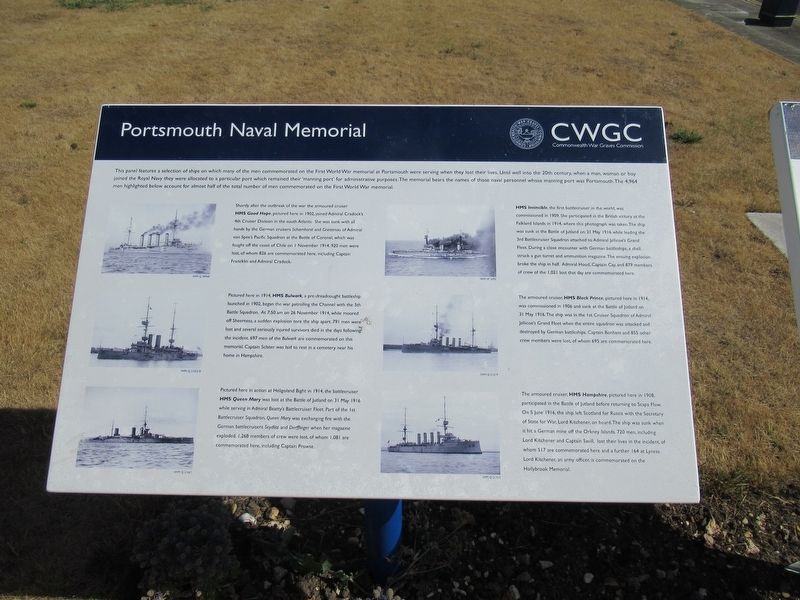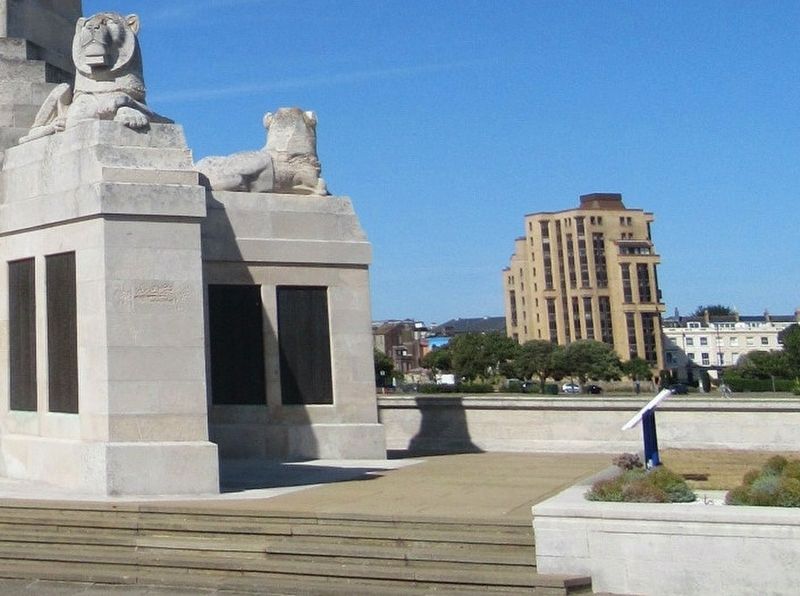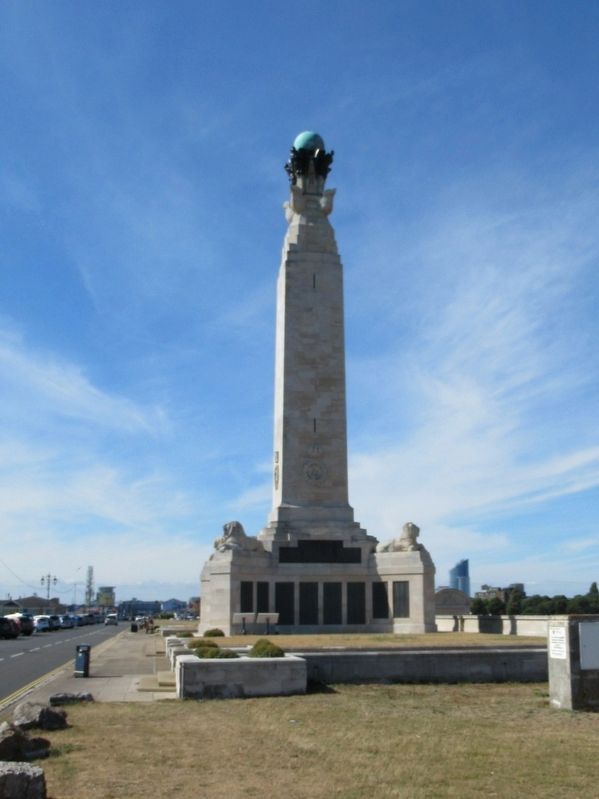Portsmouth, England, United Kingdom — Northwestern Europe (the British Isles)
Portsmouth Naval Memorial
— Ships Lost in Action —
This panel features a selection of ships on which many of the men commemorated on the First World War memorial at Portsmouth were serving when they lost their lives. Until well into the 20th century, when a man, woman or boy joined the Royal Navy they were allocated to a particular port which remained their ‘manning port’ for administrative purposes. The memorial bears the names of those naval personnel whose manning port was Portsmouth. The 4,964 men highlighted below account for almost half of the total number of men commemorated on the First World War memorial.
Shortly after the outbreak of the war the armoured cruiser HMS Good Hope, pictured here in 1902, joined Admiral Cradock's 4th Cruiser Division in the south Atlantic. She was sunk with all hands by the German cruisers Scharnhorst and Gneisenau of Admiral von Spee's Pacific Squadron at the Battle of Coronel, which was fought off the coast of Chile on 1 November 1914. 920 men were lost, of whom 826 are commemorated here, including Captain Francklin and Admiral Cradock.
Pictured here in 1914, HMS Bulwark, a pre-dreadnought battleship launched in 1902, began the war patrolling the Channel with the 5th Battle Squadron. At 7:50 am on 26 November 1914, while moored off Sheerness, a sudden explosion tore the ship apart. 791 men were lost and several seriously injured survivors died in the days following the incident. 697 men of the Bulwark are commemorated on this memorial. Captain Sclater was laid to rest in a cemetery near his home in Hampshire.
Pictured here in action at Heligoland Bight in 1914, the battlecruiser HMS Queen Mary was lost at the Battle of Jutland on 31 May 1916 while serving in Admiral Beatty's Battlecruiser Fleet. Part of the 1st Battlecruiser Squadron, Queen Mary was exchanging fire with the German battlecruisers Seyditz and Derfflinger when her magazine exploded. 1,268 members of crew were lost, of whom 1,08l are commemorated here, including Captain Prowse.
HMS Invincible, the first battlecruiser in the world, was commissioned in 1909. She participated in the British victory at the Falkland Islands in 1914, where this photograph was taken. The ship was sunk at the Battle of Jutland on 31 May 1916 while leading the 3rd Battlecruiser Squadron attached to Admiral Jellicoe's Grand Fleet. During a close encounter with German battleships, a shell struck a gun turret and ammunition magazine. The ensuing explosion broke the ship in half. Admiral Hood, Captain Cay and 879 members of crew of the 1,021 lost that day are commemorated here.
The armoured cruiser, HMS Black Prince, pictured here in 1914 was commissioned in 1906 and sunk at the Battle of Jutland on 3I May 1916. The ship was in the 1st Cruiser Squadron of Admiral Jellicoe's Grand Fleet when the entire squadron was attacked and destroyed by German battleships. Captain Bonham and 855 other crew members were lost, of whom 695 are commemorated here.
The armoured cruiser, HMS Hampshire, pictured here in 1908 participated in the Battle of Jutland before returning to Scapa Flow. On 5 June 1916, the ship left Scotland for Russia with the Secretary of State for War, Lord Kitchener, on board. The ship was sunk when it hit a German mine off the Orkney Islands. 720 men, including Lord Kitchener and Captain Savill, lost their lives in the incident, of whom 517 are commemorated here and a further 164 at Lyness. Lord Kitchener, an army officer, is commemorated on the Hollybrook Memorial.
Topics. This memorial is listed in these topic lists: War, World I • Waterways & Vessels.
Location. 50° 46.94′ N, 1° 5.744′ W. Marker is in Portsmouth, England. Memorial is at the intersection of Clarence Esplanade and Serpentine Road, on the right when traveling north on Clarence Esplanade. Touch for map. Marker is in this post office area: Portsmouth, England PO5 3LJ, United Kingdom. Touch for directions.
Other nearby markers. At least 8 other markers are within walking distance of this marker. A different marker also named Portsmouth Naval Memorial (here, next to this marker); a different marker also named Portsmouth Naval Memorial (a few steps from this marker); a different marker also named The Portsmouth Naval Memorial (a few steps from this marker); Portsmouth Naval Memorial Extension (a few steps from this marker); a different marker also named Portsmouth Naval Memorial Extension (a few steps from this marker); HMS Aboukir Yellow Fever Memorial (within shouting distance of this marker); Portsmouth Crimean War Memorial (about 240 meters away, measured in a direct line); Indian Mutiny - HMS Shannon Memorial (approx. 0.3 kilometers away). Touch for a list and map of all markers in Portsmouth.
Credits. This page was last revised on January 27, 2022. It was originally submitted on September 19, 2018, by Michael Herrick of Southbury, Connecticut. This page has been viewed 111 times since then and 13 times this year. Photos: 1, 2, 3. submitted on September 19, 2018, by Michael Herrick of Southbury, Connecticut.


